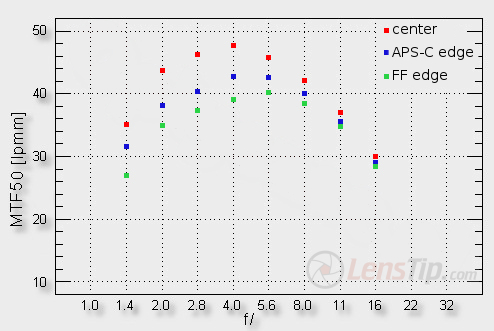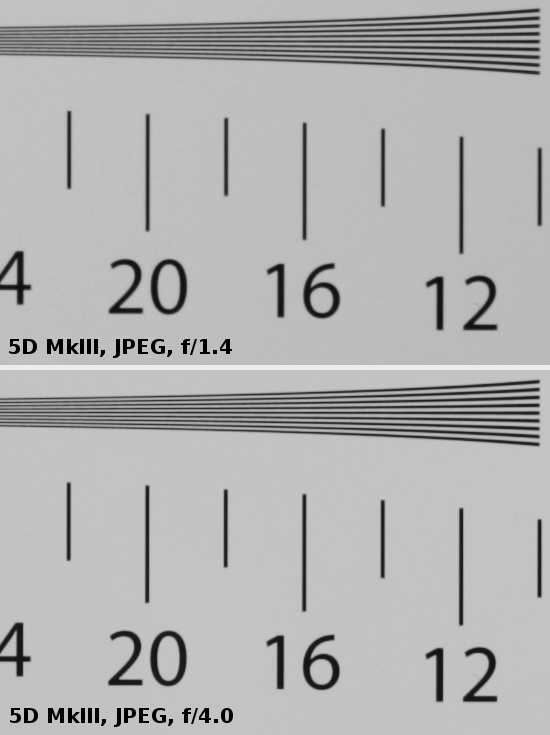Sigma A 50 mm f/1.4 DG HSM
4. Image resolution
Let’s check how the tested lens compares here. A graph below presents the results in the frame centre, on the edge of the APS-C/DX sensor and on the edge of full frame.

Please Support UsIf you enjoy our reviews and articles, and you want us to continue our work please, support our website by donating through PayPal. The funds are going to be used for paying our editorial team, renting servers, and equipping our testing studio; only that way we will be able to continue providing you interesting content for free. |
- - - - - - - - - - - - - - - - - - - - - - - - - - - - - - - - - - - - - - - - - - - - - - - -
You have to admit they make you want to clap and cheer. In the frame centre, at the maximum relative aperture the Sigma goes to 35 lpmm, exceeding notably the decency level – no mean feat because only few 50 mm f/1.4 lenses manage that much. The maximum result by f/4.0 amounts to 47.4 lpmm and is truly excellent. What’s interesting it differs in just 0.1 lpmm from the maximum result of the Sigma A 35 mm f./1.4 DG HSM, assessed by us so high.
The Sigma outclasses here almost all other 50 mm devices, including the expensive Nikkor AF-S 58 mm f/1.4 G. How it compares to the sensational Zeiss Otus 1.4/55? The Zeiss was tested on the Nikon D3x which provides MTFs very similar to both EOS bodies, just about 1 lpmm higher. If you deduct that 1 lpmm from the results of the Otus it still remains a bit sharper than the Sigma by f/1.4. By f/2.0, though, the Sigma is better and then the Zeiss is leading again. The differences aren’t big, both lenses being exceedingly sharp, but the Zeiss prevails in that duel.
On the edge of the frame the situation is a bit different. On the APS-C/DX sensor the Sigma can provide useful images even by f/1.4 and on stopping down to f/4.0 its MTFs can be only described as very good, excellent even. On the very demanding edge of full frame and by f/1.4 its results are a bit below the decency level but you can solve that problem by stopping down the lens just slightly, to f/1.6-1.8. It is a better performance than that of the Otus which had to be stopped down to more than f/2.0 in order to make the image on the edge of full frame fully useful.
The summary couldn’t have been more unanimous. Among all 1.4/50 class lenses, available on the market, only the Zeiss Otus is good enough to compete with the Sigma, tested here - it fares better in the frame center but a bit worse on the edge. If you additionally take into account the fact that the Sigma is over four times cheaper than the Otus it’s hard not to be impressed.
At the end of this chapter we present crops taken from our testing image in the frame centre. It’s worth remembering that those are JPEG files (with the lowest sharpening level applied) saved along RAW files, used for the analysis presented above.
 |






